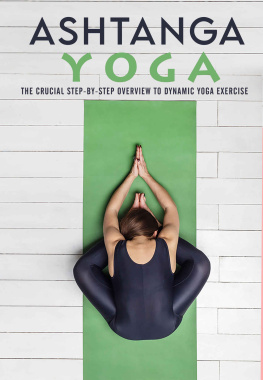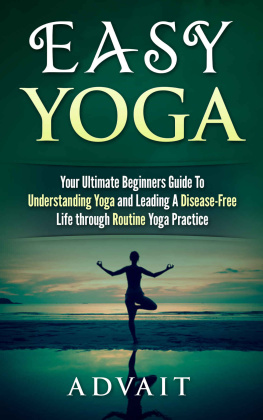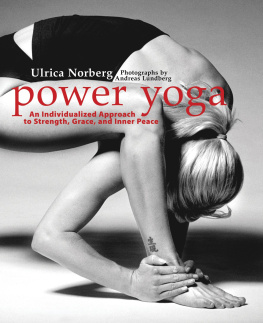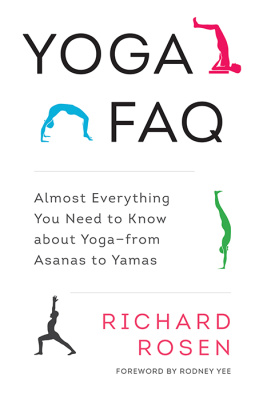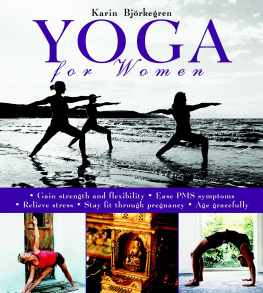
YOGA
for Strength
and Stamina
Seema Sondhi
Copyright 2006, Seema Sondhi
ISBN 81-8328-026-9
All rights reserved. No part of this book may be reproduced, stored in a retrieval system or transmitted in any form or by any means electronic, mechanical, photocopying, recording or otherwise without the prior permission of the publishers.
While every precaution has been taken in the preparation of this book, the publisher and the author assume no responsibility for errors or omissions. Neither is any liability assumed for damage, if any, resulting from the use of information contained herein.
Published by
Wisdom Tree
4779/23 Ansari Road
Darya Ganj, New Delhi-110002
Ph : 23247966/67/68
Printed at
Print Perfect
New Delhi-110064
Contents
About Yoga
What are We Made of?
The Three Forces
Strength and Flexibility through Yoga
Creating Love through Yoga
Understanding Stretching and Flexibility
Kinds of Stretching and Flexibility
Preparing to Stretch
Asanas Pranayama Relaxation Developing Home Practices Diet for Strength and Flexibility Yoga A New Beginning
About Yoga
I f you are a beginner and are considering taking up yoga to stay
strong and healthy through your life, it is important for you to understand what yoga is.
Yoga is a complete science of life that originated in India thousands of years ago. It is the oldest system of personal development in the world, encompassing the body, mind and spirit. The beauty of yoga is that anyone can practice it. There is no need for special clothes or equipment. All we need is a small space and a strong desire for a healthier and fulfilling life.
The word yoga means union, and its aim is the unity of our entire being. Yoga teaches us to lead our lives with awareness. It is about being in the present moment for the right thought and right action. Yoga is also described as an inward journey, unveiling the layers of the mind and body. It introduces us to our true self. A persons true self is his true nature, a nature that is pure and clear. Such a nature is termed satchitananda by yogis. The word sat means real, chit means awareness or consciousness, and the word ananda means bliss. The self that we are made up of is never incomplete or
in disharmony. However, living in this world makes us lose ourselves
and forget what we are capable of. Yoga is the only way to re-
introduce us to our true selves. It is the only way to reconnect.
The most common mistake people make is that they relate yoga to
the physical being. However, yoga is far beyond the physical level.
People identify themselves with their bodies; they are more aware of
what is going on at the physical level than what is going on in their
minds. The yogis were aware of this and thus devised a solution to
reach the mind or the inner being. As people connect easily with the
body, yoga teaches us to move towards the bodily sensations first.
After this is achieved, yoga moves us into the realms of the mind by
helping us to identify the sensations of the body with the thoughts of
the mind. Thus, we reach our mind, get to know ourselves and reach
a state of harmony with our true self.
There are five basic principles of yoga that can be incorporated
into our own pattern of living to provide a foundation for a long and
healthy life led with courage, strength and conviction. Here we will
incorporate the four principles that are a must to gain strength,
stamina and flexibility of the mind and the body. The yoga asanas are
excellent cardiovascular exercises that help in developing the core
strength of the body. Pranayama , that is, correct breathing, improves
the intake of oxygen and helps to release toxins that cause stiffness in
the body and dullness of the mind. Breathing is the way to the
mind one learns to control the mind through control of ones breath.
Relaxation is a must in any form of exercise and also in daily life. After exercise, relaxation relieves the tension from all the muscles and
rejuvenates the mind and the body, leaving us feeling refreshed, energised and positive. With yoga, the three factors: the body, the mind and the breath are maintained in a state of harmony. It is the union of the body, mind and breath through asanas , pranayama and relaxation, creating sublime bliss.
The fourth principle is diet. Diet is the energy put into the body in the form of food. It should make the body feel light and supple and at the same time help keep the mind calm. Moreover, our diet should be in tune with the needs of the body. The right diet goes a long way in shaping the mind and the body. By following this, we slowly learn to incorporate positive thinking and meditation in our life, removing all negative thoughts and actions. Further, it helps to still the mind, enabling it to reach satchitananda , which is our ultimate aim.
What are We Made of?
Y oga is the means to achieve a state of harmony with our true being
and with Nature. The journey is undertaken to bring about a union between the mind and the body, thus attaining bliss. However, before moving forward on this journey, we need to understand the direction in which we ought to move. That is, we need to understand what yoga implies by union and harmony of the mind and body; what yoga implies by nature.
Nature, or prakriti, comprises of three forces that are called gunas . These are also called the forces of Nature and these exist in a state of equilibrium. The three forces or gunas are a part of all that exists in our mind and body. That is, once the energy within us takes a form, it is reflected in terms of one of these three forces. Within each one of us, one of the three gunas is superior in strength and is manifested in all that we do and in the way we think, with the three forces shaping our personalities. However, we have to work on doing away with one dominating force and in its place bringing about a state of balance. In doing so, we use the gunas as a navigating force. Through yoga we recognise which of these three forces is predominant within us, thus making it easier to bring about a state of balance.
The Three Forces
T amas: People within this category are dull, gloomy and lazy. They
tend to be unconscious about the needs of others and are very greedy. The Sanskrit word tamas means blackness and darkness. This
.
signifies the dark energy within the tamasic people.
Rajas : People within this category are passionate, frenetic and creative, with tremendous amounts of energy. They are fuelled with competition and ambition, are full of desires and strive for all kinds of worldly pleasures. In Sanskrit, rajas means impure.
Sattva : People within this category are calm, balanced and peaceful, possessing clean energy. They are unselfish, compassionate, focused individuals. Sattva in Sanskrit implies pure and perfect.
Let us examine the nature of an individual. A single person is sometimes full of energy and at other times, a victim of dullness. And there are times when this very person is calm and focused. Often, people dont understand how their energies or feelings can change so drastically. The answer to this is simple: a particular human being can have the presence of all the three gunas at one time. And the shift in energy is due to the interplay of the three forces.
Humans, by nature, are sattvic . A newborn baby is relaxed as he or
she is neither touched by vices of greed nor selfishness. But as the baby
begins the journey of life, he or she moves away from prakriti, that is
Next page


